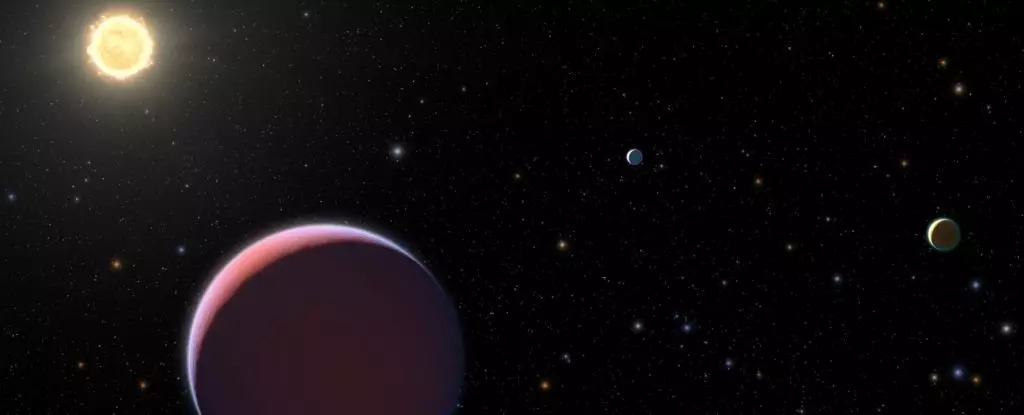Approximately 2,600 light-years away from Earth, astronomers have uncovered a tantalizing enigma in the cosmos: the Kepler-51 planetary system. Discovered in 2012, this system orbits a solar-type yellow dwarf star and is unique for its extraordinarily lightweight exoplanets, three of which are classified as “super-puffs.” Recent observations reveal a fourth planet, igniting excitement and curiosity among scientists. The discovery challenges our understanding of planetary formation and dynamics, particularly in a configuration that seems remarkable for its peculiarities.
Planets are generally classified based on their physical characteristics and compositions. The concept of “super-puff” worlds, which includes Kepler-51b, Kepler-51c, and Kepler-51d, describes exoplanets that have remarkably low density, measuring in at less than 0.1 grams per cubic centimeter. This classification suggests that these worlds possess thick atmospheres and lack solid surfaces, existing in a state similar to a fluffy cloud or cotton candy. The soft, porous nature of these planets has puzzled researchers, as such low densities are rarely observed, particularly in multiple planets within the same system.
Astronomers, led by Jessica Libby-Roberts from The Pennsylvania State University and Kento Masuda of Osaka University, conducted an extensive exploration of Kepler-51. Their efforts were aimed at further investigating the characteristics of these super-puff planets, alongside the newly identified Kepler-51e. This remarkable discovery raises crucial questions regarding the formation processes that produce not one, but four super-puff exoplanets in proximity.
The search for additional planets within the Kepler-51 system began with a transit observation of one of the known exoplanets. A transit occurs when a planet passes in front of its host star, resulting in a temporary, minute dip in the star’s brightness, which can be measured to yield information about the planet’s size and orbit. However, when the observational window opened, the expected decrease in brightness did not occur within the anticipated timeframe.
Libby-Roberts and her team faced the perplexing issue of the transit occurring two hours earlier than their calculations predicted. Realizing this anomaly prompted them to re-evaluate their models and delve extensively into historical data captured by NASA’s TESS and various ground-based observatories. Their research concluded that an unseen planet—later designated Kepler-51e—was influencing the gravitational dynamics of the system, affecting its observable parameters.
The potential existence of Kepler-51e adds another layer of complexity to the already intriguing planetary system. Based on models, it is hypothesized that Kepler-51e shares a mass similar to that of its siblings while orbiting the parent star in a relatively circular path over approximately 264 days. This orbital configuration aligns with observations from other multi-planetary systems, lending credibility to the hypothesis surrounding its characteristics.
However, without direct observation of Kepler-51e transiting its star, much remains uncertain regarding its size and density. The lack of transit data complicates efforts to characterize the planet fully. Understanding its dynamics within the system is crucial to unraveling the mystery that surrounds Kepler-51, especially in light of the incredible rarity of multiple super-puff planets existing in concert.
Moving forward, astronomers are keenly interested in utilizing both ground-based and space observatories to gain insights into the atmospheric compositions of these super-puff worlds, including Kepler-51e. By analyzing the atmospheres of these planets during transit events, researchers hope to uncover the chemical makeup and potentially glean information about the processes that govern their existence.
The Kepler-51 system could provide critical insights not only into the formation of super-puff exoplanets but also into the broader complexities of planetary system development. As data is collected and analyzed, the hope remains that the mystery surrounding Kepler-51 will gradually unveil the secrets of its existence. Thus, the future of exploration in this distant solar system serves as a testament to humanity’s unyielding curiosity and desire to explore the cosmos.
Kepler-51 is not just a single curiosity; it epitomizes an age of discovery that is reshaping our understanding of planetary science. With every new finding comes a deeper inquiry into what mechanisms formed such an extraordinary configuration in orbit around a distant star. As research continues, the task at hand remains both daunting and exhilarating—a testament to the wonders yet to be uncovered in our universe.


Leave a Reply